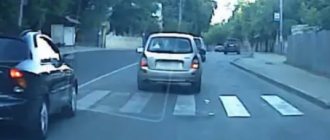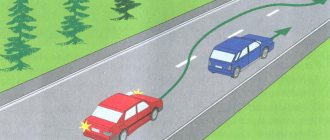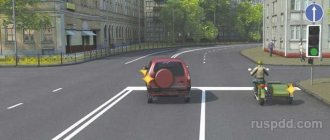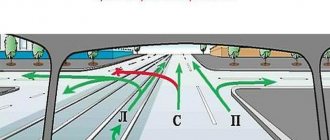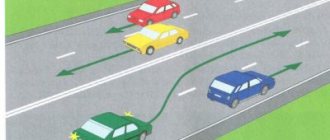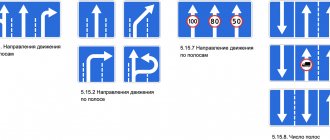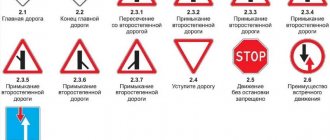Many cyclists think about using their bike as a vehicle and riding it to work, to the country, to shops, to nature... Riding on the sidewalks among pedestrians is quite problematic; there are only one or two special bicycle paths in a city with a population of one million, and even that is not a fact. There is only one option left - roads and highways, and traffic on them is equal to cars.
Not everyone knows that a bicycle is equal to a car, and on the road it is necessary to follow the general rules of movement on the roadway. Going out with a bike unprepared is absurd and dangerous, so now we will determine where and how a bicycle driver should ride and what to follow when doing so.
Bicycle safety in the “iron kingdom”
To ride a bicycle safely on the roadway you must:
- Good condition of transport.
- Required position relative to other vehicles.
- Optimal speed.
- Maintaining distance, lateral interval.
- Attentiveness, good response.
- Visibility from the outside.
- Compliance with the requirements of road signs, markings, traffic lights.
When moving along the roadway, the bicycle must be in good condition. First of all, this concerns the steering wheel and brake system. It is also necessary to check the mounting of the wheels to the frame, the condition of the transmission and the air pressure in the tires.
We decide which side of the road we need to be on. This is a rather controversial issue among cyclists: some argue that it is necessary to ride in the direction of travel, others - “against the grain”, like pedestrians - on the side of the road, others don’t care at all, even if it’s in the middle. So who is right?
Traffic regulations clearly and clearly defined the position of a bicycle on the road: passing other vehicles, moving as far to the right as possible. This could be the edge of the road, the right lane in multi-lane traffic. The key word "possible" means that traffic rules allow cyclists to veer to the left and even enter oncoming traffic. Such cases include:
- Driving around a parked car.
- Poor quality of the road surface, when driving on which you can fall and create an emergency situation.
- Driving through the scene of an accident or cordon.
A group of cyclists moves in one row, in the extreme right position, at a distance from each other. Riding parallel in one lane, as the rules allow for motorcycles, is prohibited for cyclists.
Cyclists are fish in water on the right side of the road
The speed of the bike in traffic is of great importance. According to traffic regulations, driving synchronously with the flow is the safest for each vehicle. On the road it is necessary to develop and maintain a fairly high speed, at least 20 km/h. Driving too slowly interferes with cars, as they are forced to maneuver around the cyclist. This is especially true for narrow roads, where passing oncoming and oncoming traffic is difficult. However, high speed is only safe if all traffic is moving quickly.
Cyclist signals when driving on roads
The distance for a cyclist is the distance between him and other vehicles in length. Side spacing is the distance across the width. For comfortable driving on the road, they must be maintained so that in a dangerous situation you can turn to the side. If the distance behind the car in front decreases, you need to slow down. And, conversely, speed up if it decreases with traffic behind. When moving in parallel, you should not press too close to passing and parked cars, and here’s why:
- There is a risk of falling on the car due to unevenness on the road.
- The door of a parked car may suddenly open.
- A car can hit a cyclist.
Attention is the key to successful cycling as a driver. You should carefully monitor what is happening in front and to the sides. The road is movement, and the situation changes every second. It will be useful to purchase a rear-view mirror and install it on the steering wheel: this way you can keep an eye on the road behind you.
An integral attribute of mindfulness is the reaction: the higher it is, the more opportunities there are to avoid an unpleasant situation. The reaction speed decreases when tired, taking medications and when intoxicated. In these cases, the rules prohibit driving, including a bicycle.
Peace of mind will give the cyclist the confidence to be seen. It is recommended to have reflectors on the frame, lighting devices (a headlight at the front and a flashing red light at the rear) when driving at dusk, and bright clothes, preferably also with reflective stripes.
Became visible - avoided problems and saved life
Traffic rules oblige, along with car drivers, to comply with the requirements of road signs, markings and traffic lights. Current road signs for bicycles:
- Priority signs.
- Crosswalk.
- No entry.
- Prohibiting turns.
- Prescriptive directions.
- Signs of special requirements: one-way traffic, route traffic.
- "Driving in lanes" signs.
Pay attention to the signs
Markings for cyclists:
- Solid line (no crossing allowed).
- Broken line (can be crossed).
- Pedestrian zebra crossing.
- Islands of safety.
- Yellow markings prohibiting stopping and/or parking.
As for traffic lights, everything is simple: red, yellow - stop, green - the road is clear. When the additional section of the traffic light is on, traffic is allowed after other vehicles have passed through the main green section. For a cyclist, the “right” arrow will be relevant.
Safe flight when maneuvering
Maneuvering on the road is a deviation from a straight trajectory. According to traffic rules, the driver in this situation must give way to vehicles moving straight ahead. Maneuvers on the roadway include starting to move, changing lanes, and turning. We will consider the last category in a separate section, but now let’s talk about how to properly start moving and change lanes.
At the beginning of the movement, you must give way to everyone traveling in the same direction: cars, motorcycles, other bicycles. As soon as a safe gap has formed and other passing vehicles are still far away, we deviate to the left, straighten the steering wheel and pick up speed. When turning onto the road from the adjacent territory (yards, driveways, platforms), it is also necessary to let everyone through.
Changing lanes is necessary when avoiding obstacles or moving in the permitted direction. For example, the right lane is only for right turns, but you need to drive straight. When changing lanes, the trajectory should be as straight as possible, so you need to start deviating to the left in advance. We give way to passing traffic and reduce speed. When driving around obstacles on narrow roads with an exit on the left side, you must stop and let oncoming traffic pass. If the obstacle is on the oncoming side, then the cyclist has the right of way on his territory.
Scheme of passing oncoming traffic on a narrow road
Driving through intersections and crossing roads
In general, there are four ways to drive through a road intersection: continue straight, turn right or left, or turn around. A right turn for a cyclist is allowed at all regular intersections, as it is made from the extreme right position - the legal place of the cyclist.
A cyclist can also freely ride straight from his lane, and he will have an advantage over those turning right. If the right lane is only for a turn, then to drive straight you need to change lanes into the adjacent lane, having first given way to everyone who does not intend to change lanes.
A bicycle driver is only allowed to turn left and change direction from roads where there is one lane in each direction and there are no tram tracks. By the way, about trams: at intersections they have an advantage over a bicycle; if the red light is not on for it, it does not leave the secondary road or the depot.
The tram is always the main one
Warning instructions for turning: “right” - an outstretched arm to the right, “left” and “turn” - an outstretched arm to the left. The direction of turn must be shown in advance, before the maneuver.
Giving signals when turning - good manners, serious approach
Crossroads are divided into several types:
- Unregulated, equivalent roads.
- Without traffic lights, with a certain priority.
- Adjustable.
The first type of intersections is passed according to the “interference on the right” rule. We look to the right and miss everything that moves from there. When turning left at such intersections, you must give way to the entire oncoming traffic unless it has its own obstacle on the right (to the left of the bicycle).
Driving directions “obstruction on the right”
Intersections with priority are intersections of roads where, according to the rules, some pass “without looking”, others give way. The former move along the main road, the latter are on the secondary road. On the main road, a bicycle has the right of way, just like a car. However, you need to be careful, slow down a little and pass only if they really allow you to do so.
The most unpleasant maneuver on the main road is turning left. Here you will need to first let through all the passing people, and then the oncoming ones. Sometimes the main road may change direction: there is an information board under the sign. If such a road turns left, then there is no need to let anyone through. On a secondary road, a bicycle is inferior to everyone driving on the main road if they intend to drive straight or to the left, and only to future passing vehicles when turning right.
Intersection with priority passage
Signalized intersections are usually intersections of major streets where left turns will not be permitted. There are two ways to rotate:
- Get off your bike and cross the zebra crossings.
- Drive "at the corner": straight on the green, turn 90 degrees and drive straight on the green again. This can be done where there are no pedestrian crossings, and if there are no cars parked at the edge of the road. In general, the first option is safer.
Turn left from a multi-lane road at the corner (green lines)
You are allowed to drive straight and to the right when the signal is green, including a flashing one. You can complete the intersection on yellow or even red. If the traffic light is flashing yellow or turned off, then we look at the priority signs or get off and cross the road on foot.
There are also T-shaped signalized intersections. They are interesting because you can turn left from a road without a direct passage, even if there are more than one lane. To do this, you need to move to the left lane in advance and calmly turn on green: the bicycle will be to the right of everyone and will not create interference. Don't forget to give turn signals when changing lanes and before turning.
Attention! When turning right or left, you can cross a pedestrian crossing only if there are no people on it. That is, we act like in a car: at turns we let all pedestrians pass, and we also let them complete the transition.
You need to cross the road with a bicycle with your own feet, using a pedestrian crossing. Unfortunately, many people neglect this and ride directly on the saddle. This cannot be done for the following reasons:
- You can hit a pedestrian at a zebra crossing.
- There is a danger of crashing into a curb and falling off your bike.
- A car driver turning a corner may not notice a cyclist and hit him.
The same applies to controlled crossings (without an intersection): the rules clearly state that a cyclist is required to cross the roadway as a pedestrian. A self-respecting bicycle driver always remembers where he can and cannot ride.
This is the wrong cyclist
What other traffic rules are there for cyclists?
Since cycling is permitted in places where pedestrians (and other persons) are walking, if such movement creates danger or interference with other persons moving on the sidewalk, footpath, shoulder or in a pedestrian zone, the cyclist must dismount and continue your journey on foot. Therefore, most often in an accident between a bicycle and a pedestrian, the first person is at fault.
There are also prohibitions for cyclists. In particular, you cannot:
- ride a bicycle without holding the handlebars with at least one hand,
- transport bulky cargo or cargo that will interfere with steering,
- ride someone else on a two-wheeler, if this is not provided for by its design,
- turn left or turn around on roads where there are tram tracks or more than one lane in a given direction (there are 2 exceptions, which can be read about in paragraph 24.8 of the Russian Traffic Regulations)
Well, I would like to write separately about the ban on crossing the road at pedestrian crossings. It is driving along pedestrian crossings that creates the most accidents on the roads (the same paragraph 24.8 of the Rules).
Where it is advisable to travel, not worth it, prohibited
When choosing a route, it is recommended to choose roads with low traffic: this way the ride will be more comfortable, faster, and there will be less risk of getting into an accident or being poisoned by exhaust fumes.
You can, but you should not drive on streets that are too wide and have heavy traffic. Of course, an experienced road cyclist will ride everywhere, but if there are more reasonable options, it is better to choose them. Also, do not overuse driving on highways and roads with a large number of heavy vehicles. We must remember that a truck and a bicycle are incomparable things.
It is prohibited to ride a bicycle on highways without traffic lights. The speed of cars on such roads is usually close to 90 km/h even in the right lane, and a modest 25-30 km/h is completely out of place here. It is also prohibited to ride on two wheels in tunnels.
If the rules are strictly and timely followed, cycling on the roads will be relatively safe and comfortable. To these should be added the unspoken principle of the “three Ds”, as well as being respectful and patient with other participants. There can never be too much politeness, but it will definitely return.
Fines
Traffic police officers are quite loyal to cyclists, but the law provides for fines for them too!
If you look closely at this wording, any violation committed by a cyclist should be punishable by a fine of 800 rubles. If he was not sober, then a fine of one thousand to one thousand five hundred rubles!
Fines for cyclists cannot be compared with fines for motorists. For the latter, driving while intoxicated is fifty thousand rubles!
Despite the fact that there are fines for cyclists, they are rarely fined in Russia.
In Poland, prisons are overcrowded with drunken cyclists.
Ride your bike, have fun and don't break traffic rules!
